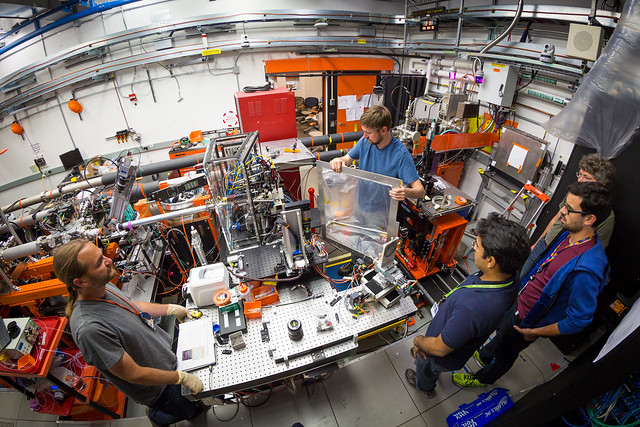MFX (Macromolecular Femtosecond Crystallography)
The MFX instrument is the prime endstation at LCLS for multi-modal crystallographic measurements at atmospheric pressure, combining macromolecular X-ray crystallography and X-ray spectroscopy. The MFX instrument uses short XFEL X-ray pulses to limit observed damage to samples during the exposure of radiation-sensitive samples, primarily biological samples, at room temperature. The “diffraction-before-destruction” concept enables accessing high-resolution structural information simultaneously to the electronic structure of metal edges in the hard X-ray regime. Exemplary samples of interest include metal-containing proteins, which are particularly sensitive to radiation damage due to the high absorption of X-rays by the metal atoms.
The strength of the MFX instrument is the ability to perform multi-modal measurements, supplementing the primary measurement technique of macromolecular crystallography. The instrument is able to support a wide range of standardized and unique sample delivery and handling methods , including liquid jets, droplet generators, fixed targets, a rapid scanning goniometer as well as custom user-supplied methods. Specifically, helium atmosphere sample environments with a wide range of environmental controls are available.
The versatile experimental capabilities are enabled by a large area sample table, as well as a floor-mounted detector mover and a ceiling-mounted detector robot and different spectrometer mounts. In order to enable optical-pump / X-ray-probe experiment, the instrument provides both femtosecond as well as nanosecond pump laser systems, both for time-resolved measurements as well as sample characterization.
For more information about the MFX instrument, please read the following article:
MFX Location
The MFX instrument is located in Hutch 4.5 of the Far Experimental Hall (FEH) of LCLS. The hutch is ~10 m long by 5 m wide and located 430 m away from the LCLS source.

MFX Videos
For more MFX related videos, see the LCLS MFX playlist on YouTube.
Download flyover animation (right click and save link as):
Instrument funding acknowledgements:
Funding for the MFX beamline construction was provided by the U.S. Department of Energy, Office of Science, Biological and Environmental Research via the SLAC Mesoscale Integrated Biology Pilot Project. Further funding was provided by the Linac Coherent Light Source (LCLS), SLAC National Accelerator Laboratory, supported by the U.S. Department of Energy, Office of Science, Office of Basic Energy Sciences under Contract no. DE-AC02-76SF00515. Further funding for MFX was provided by the National Institute of General Medical Sciences (NIGMS), the National Science Foundation (NSF) and the Howard Hughes Medical Institutes. The Stanford Synchrotron Radiation Lightsource, SLAC National Accelerator Laboratory, is supported by the U.S. Department of Energy, Office of Science, Office of Basic Energy Sciences under Contract No. DE-AC02-76SF00515.
Specific component acknowledgements:
HERA Instrument at MFX
If you fully or partially used the HERA (Helium Rich Atmosphere) environment at the MFX instrument for your work:
Use of the Linac Coherent Light Source (LCLS), SLAC National Accelerator Laboratory, is supported by the U.S. Department of Energy, Office of Science, Office of Basic Energy Sciences under Contract No. DE-AC02-76SF00515. The HERA system for in helium experiments at MFX was developed by Bruce Doak and funded by the Max-Planck Institute for Medical Research.
Rayonix 340 Detector at MFX
If you fully or partially used the Rayonix 340 Detector at the MFX instrument for your work:
Use of the Linac Coherent Light Source (LCLS), SLAC National Accelerator Laboratory, is supported by the U.S. Department of Energy, Office of Science, Office of Basic Energy Sciences under Contract No. DE-AC02-76SF00515. This work was supported by the National Institutes of Health grant S10 OD023453.
Droplet-on-Demand sample delivery platform
Acknowledgement statement for the droplet-on-demand robot at the MFX instrument:
Research was supported by the DOE Office of Science through the National Virtual Biotechnology Laboratory, a consortium of DOE national laboratories focused on response to COVID-19, with funding provided by the Coronavirus CARES Act. Also, this work was supported by NIH grant P41GM139687."
SOS fixed target chip system
The SOS system was fabricated by the Max Planck Institute for Medical Research, Heidelberg, Germany. Please cite the following publication when using:
Doak, R. Bruce, et al. "Crystallography on a chip–without the chip: sheet-on-sheet sandwich." Biological Crystallography 74.10 (2018): 1000-1007. https://doi.org/10.1107/S2059798318011634
MFX CONTACTS
Leland Gee
MFX Instrument Lead
(650) 926-3234
lbgee@slac.stanford.edu
Kelsey Banta
Area Manager
(650) 926-3819
hayes@slac.stanford.edu
Mark Hunter
BIO Department Head
(650) 926-6294
mhunter2@slac.stanford.edu
Roberto Alonso-Mori
Lead Scientist
(650) 926-4179
robertoa@slac.stanford.edu
Andy Aquila
Staff Scientist
(650) 926-2682
aquila@slac.stanford.edu
Sandra Mous
Associate Scientist
(650) 926-6225
smous@slac.stanford.edu
Fred Poitevin
Staff Scientist
(650) 926-5326
fpoitevi@slac.stanford.edu
Ray Sierra
Staff Scientist
(650) 926-3148
rsierra@slac.stanford.edu
Sebastian Dehe
Project Scientist
dehe@slac.stanford.edu
Greg Gate
Laser Scientist
(650) 926-2017
gate@slac.stanford.edu
Mike Glownia
Laser Scientist
(650) 926-5456
jglownia@slac.stanford.edu
James Baxter
Associate Scientist
(650) 926-5052
jb2717@slac.stanford.edu
Daniel Rosenberg
Associate Scientist
(650) 926-4740
djr@slac.stanford.edu
-
MFX Control Room
(650) 926-1745
MFX Hutch
(650) 926-1845



